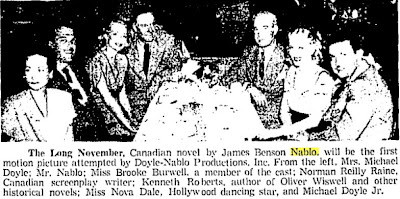
Thomas P. Kelley, King of Canadian Pulps, as imagined by Henry van der Linde
The Globe & Mail, 9 January 1982.
Apologies.
The most interesting thing about the novel is the story of Ginger Daniels, the young widow who turns up ready to work at the brothel. Hers stands out for a number of reasons, the most obvious being that she never actually becomes a prostitute. So, why include this character at all? She arrives, consumes close to a fifth of the novel with her story, then departs, never to be heard from or mentioned again.
What gives?
I think the answer has to do with the author's habit of recycling material. Plainly put, I believe Kelley was reusing material he'd penned for a romance magazine.
In No Tears for Goldie, the working girls encourage Ginger to tell her story. "You needn't tell much of the first part of your life," says Aunt Maggie, "just begin where you met that husband of yours..." And so she does, sweeping the omniscient narrator aside to speak of her love for a young lawyer named Rod, encounters with his shrew of a mother and the attempt to sabotage their wedding. The account, much more detailed than any other part of the novel, runs one full chapter, ending: "I now know that I would never have to worry about his mother again now that Rod was mine forever - and I was happy."
Happy? Happily ever after, it seems... but the narrator returns in the following chapter, and we discover that Rod died in a car accident ten days into the marriage.
Tragic.
On an unrelated matter, I was curious as to whether Kelley used "Jack C. Fleming" for any other works. True, he claimed to have employed thirty pseudonyms, but in a career that lasted nearly five decades, one might expect considerable repetition. Curiously, the only other works I've found attributed to Jack C. Fleming are mid-20th-century editions of another Canadian book, Musson's Improved Ready Reckoner, Form and Log Book, which was once used in calculating measurements for lumber and other products.
Coincidence?
I think not.































